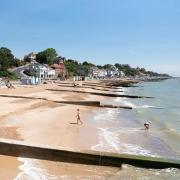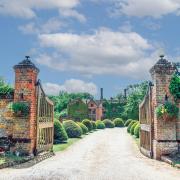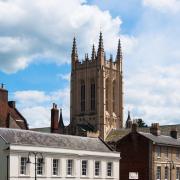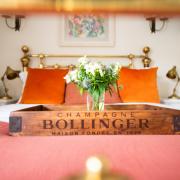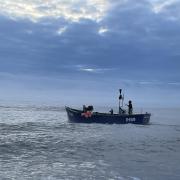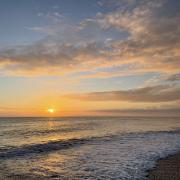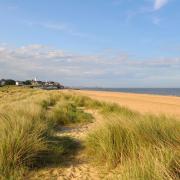If ever a building lived and breathed all things maritime it’s Felixstowe Museum. A former submarine mining station this half hidden, low profile building sits on the edge of the Landguard Peninsula, a next door neighbour to the UK’s most successful container port and a harbinger of the area’s nationally important role in naval history.
Away from the main town and beaches, the museum, which opened in 1982, harbours the tale of a town rightly proud of its naval and military past. Close by in the port’s original dock basin is the site of HMS Beehive, from where fast motor torpedo boats, gun boats and motor launches helped to protect our coastal convoys from attack by German E-boats during the Second World War. The museum is also a reminder of the very early 20th century, when the first sea planes were tested and developed at Felixstowe before being sold all over the world.

Closer to the present is a room showcasing the plastic memorabilia and screaming headlines of the 1980s, when Felixstowe like everywhere else was immersed in the mores of Thatcher's Britain. Despite its evocative themes and more recent storytelling, the museum remains a bit of a secret for many locals and visitors alike. The Landguard Peninsular, which also includes an 80-acre nature reserve and a fort dating back to Tudor times, attracts more than 600,000 visitors a year. Blink and you might miss the museum, but it’s there and well worth a visit.
'Our challenge,' says David Gledhill who chairs the overseeing Languard Trust and has taken on the chairmanship of the museum itself, 'is to get more of those people into the museum. It’s a fantastic exhibition which combines both the military and social history of the town and its surrounding area.'

As we browse the museum’s 18 rooms, covering everything from Roman artefacts to the town’s recent social history, it’s not difficult to see why David Gledhill is an enthusiastic advocate both of the museum and all things maritime. He has spent his career in ports and logistics and was chief executive of Hutchison Ports UK, which ran both the Port of Felixstowe and Harwich International Port, a role he left in 2015 to take up new challenges as CEO of the Port of Salalah in Oman and then Port Elizabeth in America, one of the gateway ports of New York harbour. He retired in 2019, returning to Felixstowe and took on his current role in 2021 when the trust was formed.
Visitor numbers at the museum are rising he says and the onus, of late, has been on coinciding opening times for the different Landguard facilities so that a visit to one can mean enjoying another, or in the case of the museum sampling a snack and refreshments at the recently opened,and aptly named, Beehive Café. When all this is done, there’s also the option of taking a short hop across to Harwich on the foot passenger ferry. (Did someone mention a mural by Banksy on the other side?)
The backdrop to all these activities is the industrial hub that is the Port of Felixstowe and those huge container ships. As David notes: 'The port has kept on expanding, getting closer to the facilities at Landguard, and it has to make sure it stays a good neighbour.' His connection with Landguard is personal.

'My office was at Tomline House (part of the port) and I was able to sit and look across to Landguard,' he remembers. 'Chairing the trust has been about bringing the different parts together, and really showing visitors what we have to offer here.' A key challenge, he says, is getting enough volunteers to extend opening times beyond the current Thursday to Sunday. 'We had a very successful recruitment day and well over 100 people signed up to say they were interested. What we’re trying to do is sign up volunteers for the fort and the museum.'
Those who come can enjoy being steeped in the history and relics of a bygone age, as well as appreciating the area’s claim to a place in our maritime history. A recent event at the museum, hosted by Suffolk publisher Julia Jones, highlighted the role of war hero Lieutenant-Commander Robert Hichens, who was based at HMS Beehive and played a key role in defending our coastal shipping in the Second World War.
'Hitch', as he was known, was killed in April 1943, but left a remarkable manuscript, We Fought them in Gunboats, which could only be published in censored version. Julia Jones has republished the original text, uncensored but carefully edited. While David admits to filling in the Beehive Dock during his time in charge of the Port of Felixstowe, it is marked out with pink paving stones as a permanent memorial. There's a map in the museum which highlights the area.

The shape and location of the museum is itself a reminder of the building’s defensive role as a submarine mining station, originally built in 1878. The building housed so-called non-contact mines, which were laid out in the channel but were safe until activated back on land. 'They were connected by a cable running back to the fort,' explains David. 'There were a few of these buildings around the world but this is the last one left.'
Walking from room to room in the museum it’s not difficult to see why David and his band of volunteers are so passionate about the collection. The model seaplanes, for example, were all hand crafted in wood by an enthusiast and demonstrate the area’s pioneering role in developing this form of transport. On a larger scale are models of Townsend Thorensen car ferries – remember the plastic carrier bag for duty frees? – which took people away for their exotic foreign holidays. And the 1980s room, which oozes nostalgia for people of a certain age, are David Bowie and Adam and the Ants record sleeves and the first Motorola mobile phone, dating back to 1984, which was the size and weight of a standard house brick.
There are the anecdotes too. David points out that TE Lawrence - Lawrence of Arabia - was based at Felixstowe after the First World War. As Aircraftman Shaw, he got involved in the development of the fast patrol boats. Felixstowe, notes one display, once had the second longest pier in Britain.
And there's the story of the weekend paddle steamers which docked in Felixstowe on their way up the East Coast in the 1930s, with women and children aboard, but no husbands. The husbands had to work on Saturday mornings, so they joined their families later, travelling on another ship known as the 'booze cruise', where the blokes could slake their after-work thirst. Like those demob-happy husbands, a visit to Felixstowe Museum and its surroundings is a journey to remember.

Don’t forget the Beehive Room
If you’re paying a visit to Felixstowe Museum don’t forget to check out the Beehive Room which tells the story of wartime courage and heroism in protecting our coastal convoys.
HMS Beehive was located in the old Dock Basin next to the museum and became famous as a centre for Motor Torpedo Boats (MTBs) and Motor Gun Boats (MGBs), super-fast craft designed to counter the threat of German E-boats from 1940. It also found a place on the national stage because of the leadership and derring-do of men like Lieutenant Commander Robert Hichens, an experienced yachtsman who joined the Royal Navy Volunteer Reserve (RNVR) and made his mark leading a flotilla of MGBs to sink numerous German E-boats from HMS Beehive.
'Hitch as he was known became nationally famous for his courage and tactical thinking,' says local publisher Julia Jones, who recently hosted an event at the museum to commemorate the 80th anniversary of Hitch’s death. 'He took on the E-boats from Beehive in his high-speed, highly vulnerable little ships. Beehive was a working community where people helped and supported each other doing vital work towards the war effort.'
The museum’s Beehive Room includes a fitting tribute to a man who, perhaps inevitably, was killed in April 1943, risking all in another mission to take on the E-boats.
About Felixstowe Museum
Felixstowe Museum and the Beehive Cafe View Point Road, Felixstowe, IP11 3TW
Open Thursday to Sunday, 11am to 5pm until the end of October.
The museum hosts events throughout the year. Follow it on Facebook
felixstowemuseum.org




